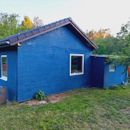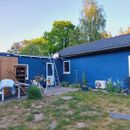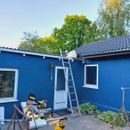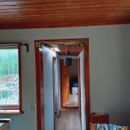Insulating an old offset L shaped 1/12 and 5/12 house
Hi and thanks for reading,
We live in North Denmark and have an old 50’s concrete block house, single wall with absolutely no interior wall insulation. Our summer’s rarely get above 30 deg and winter is fairly mild between -5 and +5, pretty windy and rainy all year round but the snow doesn’t really build up much or last long.
Our house was built in 2 stages a long time ago, a 5/12 peaked roof main house and an offset low slope roof 1/12 added later that really seems to be out of place. If it was a true L shape we’d put a peaked roof on it, but half of it extends past the other half of the house and we can’t see a way to do that.
Last summer we replaced the peaked roof that was 1 M3 asbestos plates. We reinforced and realigned the trusses, raised the heels, added poly to the bottom of the trusses and 30 cm of rockwool above and between. We made a continuous soffit and a continuous roof vent with underlay over the trusses, under the battens and into the gutters. A cold roof that was a big improvement but the heat pump still never shuts off in the winter.
We now want to replace the flat roof half with a warm roof, 10 cm EPS sandwiched between 2 layers of OSB and an EPDM or asphalt roll top, 10 cm EPS exterior foam around the whole house, and new internal 2×4 walls with rockwool stuffing throughout both halves and furring and horizontal old style siding after all of that is done to encapsulate and hide the ugly block and plaster.
My concern is the 2 different styles of roof and the vapor barriers in different places, and how the 2 halves are internally open to each other. I’m sure somehow this is a mistake and I’m unsure how a standard peaked cold roof can join a warm flat roof without me messing up the vapor barriers for walls and roof(s). For example for now the only vapor barrier is above the wood profile ceiling in the peaked half of the house, the flat half of the house would get that barrier outside the brick and above the OSB. I don’t know how to as Martin says “draw a continuous line of insulation” and the vapor barrier too. We live in the countryside out of the town with no kids and plenty of time this summer to do this we think, we’ll live in the garden in a big tent this summer to do all this (also ripping up the concrete floor and adding sub grade EPS under the new concrete, and all new water everything as the hot water heater is in the garage and the drains are just open boxes to drop into). We’ve consulted 2 carpenters and an engineer and all 3 have no experience with external insulation or warm roofs, and their advice is opposite everything I read here. They suggest tradional cold vented flat roof and poly inside with rockwool between the new studs, but after reading so many GBA articles I want a better performance if I spend my summer knocking down and building up. Also the floor plan is just a few narrow rooms, we can’t push things inside more than 2×4 internal framing (needed to get square and sturdy walls for drywall that we do not have now).
But regardless I am sure my plan is wrong. And there’s details I cannot find information on applicable to my situation, so I ask: What would you do if this was your house? We’re open to any suggestions at all and haven’t commited to anything except the new cold peaked roof.
Kind regards and thank you for reading this,
Søren and Bettina
GBA Detail Library
A collection of one thousand construction details organized by climate and house part













Replies
10cm of roof insulation is not much, I would aim to have about the same R value on the roof as on the walls though. You are also in a pretty mild climate, so I would not loose too much sleep over it if you install less.
For the unvented roof, the air barrier typically is the lower OSB layer. You want to tape the seams on it to air seal, this air barrier should tie into your wall air barrier. Typically this would be the exterior sheathing but with block wall, I would tie in to the house wrap over the block.
On the vented roof side, the air barrier of the unvented roof should tie in to the air barrier there. By the sounds of it that is the poly under the trusses.
If you are tight on space, you can go for smaller studs and put more rigid on the outside. Once you are adding 10cm of rigid, going to 17cm is not all that much more work and about the same assembly R value as 10cm+2x4studs with batts. The interior can be strapped out with smaller lumber (ie 1x3 on flat) and install your interior finish over this.
By the sounds of it the place is slab on grade, in which case some exterior bellow grade insulation around the outside perimeter would also not hurt.
Thank you Akos for your insight. I have a few more questions regarding a few more issues and problems about this but it's best if I can show you in a photo or 2. I'll take some tomorrow along with a general mockup of what the unvented roof might look like, I just picked up some materials and will try to lay it out and snap a photo, I'm just very nervous of screwing it up :)
So something I can't figure out is I cannot seem to find any flat roof details in the detail library or just searching the site, so I've gotten schematics from other sites and youtube videos which always seem to be UK builders that may or may not be doing things correctly, but certainly don't seem to have the head full of knowledge that many users of this site do.
One aspect that I'm struggling with the flat roof is an overhang. We get way to much rain in Denmark to go without and it seems that most flat or low slopes have just enough overhang to correctly flash the top edge and install gutters. I found a Matt Risinger youtube video where he made LVL outriggers set 1/2 way into the rigid roof foam thereby breaking the thermal bridge to the Joists. I drew up a diagram that looks less than professional that could apply to me, it's at the bottom. There's also a photo from the flat roof today with the wave plates removed showing the 3.02 meter clear span and how I have only 30 cms or so vertical space to squeeze in the flat roof assembly before hitting the peaked roof, with a 30 cm or so overhang as it is currently is, reduced to 15 cm after the rigid wall foam and furring/cladding, before hitting the peaked roof's overhang. Not much at all. The peaked roofs poly is sealed to the block wall inside about 1/2 way up the bottom Hardee board, and that should tie into the 1st OSB or VCL on the 1st OSB, and I'm completely unsure how that could be accomplished. In addition my external block walls all around are pretty wavy from multiple layers of inconsistent plastering, so the ext. rigid foam may be hard to attach without custom furring them inboard. Perhaps my dream of a modern external insulation envelope and warm flat roof is not reasonably accomplishable? A cold flat roof and eating into the interior space for 15 cms of rockwool and internal poly for a dismal R-19 or so makes me pretty depressed. The wife is getting very annoyed about my analysis paralysis, she just wants to see a roof going up now and doesn't care for my speeches about why it should be externally insulated and I need time to figure it out. Any thoughts gentlemen?
Your sketch looks good, I have no problems with any of the details. The overhang support as shown is a good option in your case.
Our code also allows small overhangs like that to be pretty much supported by the sheathing only. The framing underneath can then be screws onto the rafters through the exterior foam.
Dealing with crooked walls is a pain. Now way around shimming the strapping if you want it flat. I would attach the rigid first than tack up the strapping at the top and bottom so that it is level and in plane with the rest. Shim and screw the middle section to keep it flat as needed.
Don't worry about trying to get to the poly inside the vented roof. Seal the air control layer of the new flat roof to the outside of the block wall and call it a day.
Make sure to follow the details of your EPDM supplier for the roof to wall intersection. The EPDM should go up the wall and be flashed with metal that is lapped by the facia trim of the sloped roof. These are typically trouble spots so extra care is important.
Thank you so much for the help Akos, it means the world to me. That sets my mind at ease that it can indeed be done. Below is a very rough mockup in 2 pictures. Just a few small questions: See how close to the drip nose the highest point is? I can bend the alu up a bit to get the membrane under it, but just barely. Perhaps the 2x4 the joists are sitting on can be ripped down a small bit? And perhaps single ply roof asphalt is a safer bet, as a small overhang could be constructed the way you suggested for the rest of the roof that isn't constrained by the 5/12 roof, without worrying about a single giant piece of rubber? Finally, when I say wavy I am being very euphemistic. Random is a closer word to describe the plaster. By the time the vertical foam is up and attached it'll look crazy, with lots of expanding foam to have any chance of sealing the gaps. If I make sure it's complete, is that still acceptable for the foam?
--
Set the 2x4s to sit on a ledger lagged to the inside of the CMU, there are also top flange joist hangers here so you don't need a ledger but don't know about the other side of the pond.
You need more space for proper details there otherwise you have pull off the bottom row of roofing tiles and carry the flat roof up onto the sloped which is more work than dropping the 2x4s.
Single ply ashpalt is not any better than EPDM and tends not to last as long.